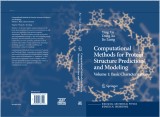Details

Computational Methods for Protein Structure Prediction and Modeling
Volume 1: Basic CharacterizationBiological and Medical Physics, Biomedical Engineering
|
149,79 € |
|
| Verlag: | Springer |
| Format: | |
| Veröffentl.: | 24.08.2007 |
| ISBN/EAN: | 9780387683720 |
| Sprache: | englisch |
| Anzahl Seiten: | 396 |
Dieses eBook enthält ein Wasserzeichen.
Beschreibungen
An ultimate goal of modern biology is to understand how the genetic blueprint of cells(genotype)determinesthestructure,function,andbehaviorofalivingorganism (phenotype). At the center of this scienti?c endeavor is characterizing the bioch- ical and cellular roles of proteins, the working molecules of the machinery of life. A key to understanding of functional proteins is the knowledge of their folded str- tures in a cell, as the structures provide the basis for studying proteins’ functions and functional mechanisms at the molecular level. Researchers working on structure determination have traditionally selected - dividual proteins due to their functional importance in a biological process or pa- way of particular interest. Major research organizations often have their own protein X-ray crystallographic or/and nuclear magnetic resonance facilities for structure - termination, which have been conducted at a rate of a few to dozens of structures a year. Realizing the widening gap between the rates of protein identi?cation (through DNA sequencing and identi?cation of potential genes through bioinformatics an- ysis) and the determination of protein structures, a number of large scienti?c init- tives have been launched in the past few years by government funding agencies in the United States, Europe, and Japan, with the intention to solve protein structures en masse, an effort called structural genomics. A number of structural genomics centers (factory-like facilities) have been established that promise to produce solved protein structures in a similar fashion to DNA sequencing.
A Historical Perspective and Overview of Protein Structure Prediction.- Empirical Force Fields.- Knowledge-Based Energy Functions for Computational Studies of Proteins.- Computational Methods for Domain Partitioning of Protein Structures.- Protein Structure Comparison and Classification.- Computation of Protein Geometry and Its Applications: Packing and Function Prediction.- Local Structure Prediction of Proteins.- Protein Contact Map Prediction.- Modeling Protein Aggregate Assembly and Structure.- Homology-Based Modeling of Protein Structure.- Modeling Protein Structures Based on Density Maps at Intermediate Resolutions.
Dr. Ying Xu is Regents-GRA Eminent Scholar and Professor at the University of Georgia. Dr. Dong Xu is the Director of the Digital Biology Laboratory at the University of Missouri-Columbia. Dr. Jie Liang is the Director for the Center for Bioinformatics at the University of Illinois at Chicago.
<P>Volume one of this two volume sequence focuses on the basic characterization of known protein structures as well as structure prediction from protein sequence information. The 11 chapters provide an overview of the field, covering key topics in modeling, force fields, classification, computational methods, and struture prediction. Each chapter is a self contained review designed to cover (1) definition of the problem and an historical perspective, (2) mathematical or computational formulation of the problem, (3) computational methods and algorithms, (4) performance results, (5) existing software packages, and (6) strengths, pitfalls, challenges, and future research directions.</P>
Addresses a broad interdisciplinary audience in biophysics and biochemistry, molecular and cell biology, computational biology, and bioinformatics Provides a comprehensive overview of protein biophysics for both professionals and graduate students Presents computational methods for all major aspects of protein structure analysis
<P>This book provides systematic technical expositions of the computational methods for all major aspects of protein structure analysis, prediction and modeling. The chapters have been designed to address comprehensively the main topics of the field. In addition, chapters will be connected seamlessly through a careful design of the overall structure of the book. Topics have been selected carefully so that the book would be useful to a broad readership, including students, postdoctoral fellows, professional practitioners, as well as bioinformatic experts who want to brush up topics related to their own research areas. The book can be used as a textbook for upper undergraduate-level or beginning graduate-level bioinformatics courses. To facilitate learning, four appendices describing the prerequisites for reading this book have been included, in (1) biology, (2) computer science, (3) physics and chemistry, and (4) mathematics and statistics.
<P></P>Each chapter in the book is a self-contained review of a specific subject, designed to cover the following material: (1) the problem definition and a historical perspective, (2) mathematical or computational formulation of the problem, (3) computational methods and algorithms, (4) performance results, (5) existing software packages, and (6) the strengths, pitfalls, challenges, and future research directions.
<P></P>Each chapter in the book is a self-contained review of a specific subject, designed to cover the following material: (1) the problem definition and a historical perspective, (2) mathematical or computational formulation of the problem, (3) computational methods and algorithms, (4) performance results, (5) existing software packages, and (6) the strengths, pitfalls, challenges, and future research directions.
Diese Produkte könnten Sie auch interessieren:

Alzheimer's Disease: Cellular and Molecular Aspects of Amyloid beta

von: J. Robin Harris, Falk Fahrenholz

213,99 €















